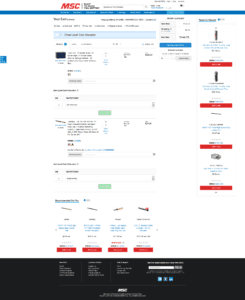Making a purchase on a major aerospace B2B e-commerce site or portal such as Modification Marketplace from The Boeing Co. or My Aviation Portal from Honeywell Aerospace is a complex transaction.

Mike Roth
Before making a final purchase, buyers have to research products that may involve multiple purchasing parties and complicated individual product specifications.
But in the end, those buyers placing orders online for advanced avionic replacement parts for rotary and fixed-wing aircraft worth several hundred thousand dollars—or even buying a jet engine for millions of dollars—are putting their final selections into a shopping cart. “With a shopping cart, we can make the most complex orders simple, thus making our online ordering application even more enticing to use,” says Honeywell Aerospace director of digital experience David Timothy.
Shopping carts—an e-commerce tool as basic to a business-to-consumer site as a product search engine and inventory—are now becoming more of a fixture across a wider range of B2B e-commerce sites from password-protected portals operated by major Fortune 100 manufacturers to niche sites offered by big and small manufacturers, dealers, distributors and wholesalers.
But while the shopping cart icon may look the same on a B2B or B2C site, the shopping cart function plays a different and much larger role for buyers on a B2B site for product management, project maintenance and bid specifications. For example, on Boeing’s Modification Marketplace, which carries nearly 12 million parts through the Boeing PART Page and Aviall’s e-commerce site, the shopping cart lets buyer not just make a direct purchase using a corporate credit card but also create and pay electronic invoices using electronic data interchange and electronic funds transfer. Aviall is an aircraft parts and services business operated by Boeing.
The My Aviation Portal from Honeywell Aerospace, for example, the cart lets customer purchase from among a product inventory of about 1.5 million parts across 20 product categories. But fleet mechanics, procurement specialists and other buyers also use the cart as a key project planning and management tool, Timothy says. “A shopping cart is a familiar artifact and serves as a productivity tool,” he says. “When it comes to placing large orders, sometimes other work can get in the way—it was important that our users could save their progress to ensure that they didn’t have to repeat work.”
On most business-to-consumer sites, the shopping cart pages gives shoppers lots of options, such as additional product recommendations, choice of shipping options, recently viewed products and multiple payment methods, among other features.
But a shopping cart on a B2B site does that and more, says Lauren Freedman, president of The E-tailing Group, an e-commerce consulting and research firm. For a B2B shopping cart, it first needs to be easy to use, she says. “In many ways the more sophisticated sites have taken a page from B2C with very user friendly interfaces,” she says.
A shopping cart for a B2B site also has additional features that give buyers options to quickly view such things as shipping policies, return options and contact information; have limited number of steps to checkout; access to live chat; and options to save shopping cart pages to be used later for current and planned projects, Freedman says
“A B2B shopping cart can serve as a holding pen for products of interest,” Freedman says. “The ability to hold products for future access or share a cart for personal needs or to collaborate with others are other good features.”
At MSC Industrial Supply, which carries a broad selection of more than 1 million maintenance, repair and operations products that business customers purchase to manage their facilities, the company has had a shopping cart on its website since it launched e-commerce in 2000, says senior director of e-commerce Mike Roth. The cart has evolved over time as the website has been updated and customers began using the shopping cart as a tool for more than just completing a purchase. “A lot of customers use the shopping cart function to manage their supply chain,” Roth says.
As a supply chain planning tool, MSC’s shopping cart can be directly integrated into a customer’s enterprise resource planning system, allowing customers to view payments and invoicing, assign product purchases to the correct cost allocation center and gain access to negotiated pricing if the company is a corporate, government or national account customer. “Customers frequently use the shopping cart as a running project list and as a workflow tool to manage costs,” Roth says.
MSC does about 60% of all sales digitally, including sales received through its e-commerce site MSCDirect.com and internet-connected vending machines based at customer locations. Recently MSC Industrial Supply has updated its shopping cart pages with responsive design, which means page content and the cart now fit any screen size. Other more recent updates include save previous shopping cart visits, view order confirmations, correct order errors and view recommended products.

MSCDirect.com shopping cart
As the shopping carts on B2B e-commerce sites have evolved over time, especially as supply chain and account management tools, more companies are now using shopping carts in different ways for different groups of customers, says Lori McDonald, CEO of e-commerce services and website design firm Brilliance Business Solutions. “We have companies where the shopping cart is the only way high-repeat-order customers want to make a purchase, and we have companies where the shopping cart is used as a tool to help sales representatives work with customers on an individual basis to complete complex orders,” she says.
If a B2B website doesn’t have a shopping cart as a purchasing and supply chain tool for customers to use, the odds are it will—and sooner than later, McDonald says. “A shopping cart will probably eventually become a necessity on any business site that takes customer orders,” she says. “I think a big driver of that trend is keeping up with Amazon Business, which makes making a business purchase convenient.”
On a typical B2B e-commerce site it might take a customer about five clicks to complete an order, depending upon such variables as whether the purchase is for a new or repeat order and the complexity of the products or services the customer is buying, McDonald says.
As B2B shopping carts evolve, the big challenge for many sellers is making the shopping cart pages even easier and more convenient to use. “The shopping cart on B2B site is moving beyond just being a tool to make a purchase,” McDonald says. “Whatever form that takes the experience needs to be easy and convenient for the customer.”
Some companies such as Honeywell Aerospace are already taking steps to make their carts easier to use. For example, updated product pages now let customers to use a shopping cart or request a quote directly from the search results page, Timothy says. “The simple act of including details within the search results allowed for a massive improvement in efficiency and an overall reduction in the time it took to process a single order,” he says. “The value was exponential for larger product orders.”
The payoff for Honeywell is that faster access to a shopping cart integrated with better site search has reduced by 20% the number of steps customers need to complete an online order, and by 50% the time to it takes Honeywell to process orders. The company didn’t provide more details.
At OfficeSupply.com, which carries an inventory of about 160,000 products across 11 categories ranging from ink and toner to office furniture, the site’s shopping cart has gained new features over time that include product recommendations, estimated delivery dates and the ability for customers to use such third-party payment services as PayPal.
In the next year, OfficeSupply will add more options to its shopping cart pages such as order authorizations and spending limits tied to specific customer accounts. “The shopping cart and order management functions we do are getting more into web-based procurement,” says OfficeSupply.com vice president of sales and marketing Joe Schaefer.
The online distributor, which handles about 500,000 orders annually, expects e-commerce sales to grow by around 20% this year, he says.
The importance of updating the OfficeSupply.com shopping cart with new features is tied to a bigger goal of easier and more convenient customer account management, Schaefer says. “It’s all about transparency for us,” he says. “We view the shopping cart as one important component to the whole process of account management.
Sign up for a complimentary subscription to B2BecNews, a newsletter published four times a week with coverage of technology and business trends in the growing B2B e-commerce industry. B2BecNews is owned by Vertical Web Media LLC, which also publishes DigitalCommerce360.com, Internet Retailer and Internet Health Management. Follow Mark Brohan on Twitter @markbrohan.
Follow us on LinkedIn and be the first to know when new B2BecNews content is published.
Favorite